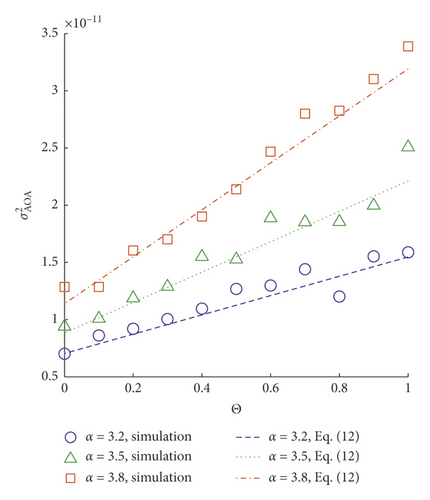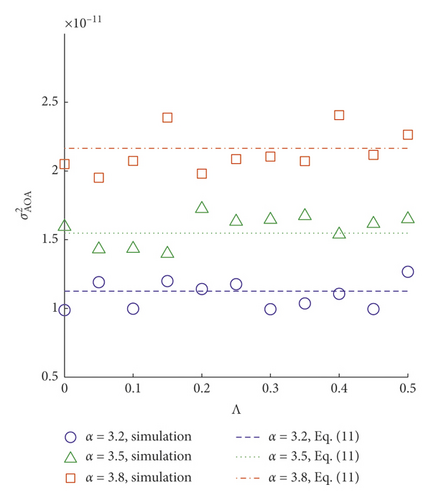An Empirical Model of Angle-of-Arrival Variance for a Gaussian Wave Propagation through Non-Kolmogorov Turbulence
Abstract
This paper proposes an empirical model of the angle-of-arrival (AOA) variance for a Gaussian wave propagating through the weak non-Kolmogorov turbulence. The proposed model is approximately expressed as the linear weighted average between the AOA variances of the plane and spherical waves. The Monte Carlo method is applied to validate the proposed model. The numerical simulations indicate that, under the geometrical optics approximation, the AOA variance for a Gaussian wave is insensitive to the change of the diffraction parameter and can be closely approximated by a simple linear relationship in the refraction parameter. These two properties ensure the validity of the empirical model.
1. Introduction
Optical wireless communication technology has attracted widespread attention during the past few decades. It adopts unguided laser beam propagating in random media to carry the digital signal for data transmission with high data rates. The random media, however, may contain numerous invisible turbulent eddies, which fluctuate the refractive index inside the random media and distort the equiphase wavefront of the laser beam. Considering that the equiphase wavefront in the vacuum is undistorted and uniform, AOA can be defined as the angle between the normal vectors of the distorted and undistorted equiphase wavefront. It is generally accepted that AOA could hardly degenerate the quality of the imaging spot, but will lead the focus position to deviate from the optimal point. This phenomenon is equivalent to the geometric misalignment between the receiving and transmitting antennas [1–3].
AOA stochastically fluctuates with the changes in both temporal and spatial dimensions, and the degree of the AOA fluctuation is conventionally described by its variance. In recent years, theoretical models of the AOA variances for plane and spherical waves have been fully analyzed based on different turbulent power spectrums [4–15]. However, the research on the AOA variance for a Gaussian wave still needs further discussion. Gao et al. [16] proposed a heuristic model of the AOA variance for a Gaussian wave propagation through non-Kolmogorov turbulence, but lacked adequate evidence to ensure the validity of the expressions. Regarded as an increment to the previous literature studies, this paper not only investigates the similar scenario but also conducts simulations for experimental verification. The rest of the paper is organized as follows. Section 2 presents the theoretical models of the AOA variances for different types of laser beams. In Section 3, numerical simulations are performed, followed by conclusions in Section 4.
2. Theoretical Models
2.1. AOA Variances for Plane and Spherical Waves
It is found that under GOA, the AOA variances are independent to λ. This property has been confirmed under various situations [15, 16, 18].
2.2. AOA Variances for a Gaussian Wave
The Gaussian beam is a representative type of the electromagnetic wave, with normally distributed transverse electric field and intensity [19]. The mathematical description of a Gaussian wave usually depends on the wavelength λ and the waist radius w0. For the optical wireless communication, more parameters are necessary to determine the location of both the transmitter and the receiver. The curvature parameter Θ0 = 1 − L/R0 and the Fresnel ratio , two nondimensional scalars, are related to the transmitter, where R0 is the radius of curvature of the phase wavefront at the transmitter and W0 is the radius where the intensity reduces to 1/e2 of the axial values at the transmitter. Similarly, there are also three nondimensional scalars, the refraction parameter , the complementary parameter , and the diffraction parameter Λ = λL/πW2, related to the receiver, where is the beam radius in a vacuum at the receiver.
Equation (12) is inspired by [20], which investigated the on-axis scintillation index for a Gaussian wave in the saturation regime.
3. Numerical Simulations
This section adopts the Monte Carlo method to validate equations (11) and (12), respectively. In our simulations, the distorted equiphase wavefront is generated by the stochastic phase screen with the first 496 terms of the Zernike polynomials, whose theoretical formulae are presented in Section 4.1. Afterwards, over 50 points are stochastically sampled on the surface of the distorted equiphase wavefront, and the corresponding AOA can be computed by their normal vectors. For each combination of optical parameters, the simulations are repeated 100 times, and the AOA variance can be statistically estimated by the empirical data. Other default settings are listed as follows: α ∈ {3.2, 3.5, 3.8}, , λ = 1.55 × 10−6 m, k ≈ 4.05 × 106rad/m, L = 4000 m, and d = 0.1 m > lF = 0.078 m.
To validate equation (12), Λ is fixed at 0, whereas Θ is assigned to 11 points linearly spaced between and including 0 and 1. Particularly, Θ = 1 refers to the plane wave, and Θ = 0 refers to the spherical wave. The simulation results are depicted in Figure 1, where the dots stand for the experimental values, and the lines stand for the theoretical values. It can be identified that there is linear relationship between and Θ. Thus, equation (12) is valid within the range of the allowable error.

To validate equation (11), Θ is fixed at 0.5. Considering that the optical wireless communication systems usually adopt the collimators to parallel the outgoing beam at the transmitting antenna, Λ is assigned to 11 points linearly spaced between and including 0 and 0.5. Figure 2 illustrates the simulation results. It is evident that due to the observational errors, the experimental values of fluctuate around the theoretical values of , and the margin of the relative error is less than 15%. Thus, equation (11) is valid for d > lF. This phenomenon can be explained physically. The validity of equation (11) is associated with the validity of equation (10). The condition “d > lF” ensures the validity of GOA, which implies that diffraction effects are negligible and can be generally characterized by the limiting case with λ⟶0. Hence, equation (10) is valid under GOA.

4. Conclusions
- (1)
The AOA variance for a Gaussian wave is insensitive to the change of the diffraction parameter
- (2)
The AOA variance for a Gaussian wave can be closely approximated by a simple linear relationship in the refraction parameter
These two points ensure the validity of our proposed model.
It should be pointed out that the phase screen based on the Zernike terms is capable of characterizing the low-frequency component, but is insufficient to describe the high-frequency component. However, the high-frequency component, associated with the small-scale turbulent eddies, makes little contribution to the phase fluctuation of laser beam. Considering that AOA is directly connected with the phase fluctuation, the forementioned weakness could hardly invalidate the conclusions.
4.1. Stochastic Phase Screen with Zernike Polynomials
4.2. Tangent Plane and Normal Vector
Conflicts of Interest
The authors declare that there are no conflicts of interest regarding the publication of this paper.
Acknowledgments
The authors want to thank Lingling SU from Chengdu CORPRO Technology Co., Ltd., Lingjun LI from Chengdu Technology University, and Yueting ZHOU from Patent Examination Cooperation Jiangsu Center of the Patent Office, CNIPA.
Open Research
Data Availability
The data used to support the findings of this study are available within the article.




